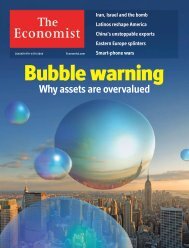Untitled - the ultimate blog
Untitled - the ultimate blog
Untitled - the ultimate blog
Create successful ePaper yourself
Turn your PDF publications into a flip-book with our unique Google optimized e-Paper software.
The basic problem is that although <strong>the</strong> Asian economies have<br />
decoupled from America, <strong>the</strong>ir monetary policies have not. In a<br />
world of mobile capital, an economy cannot both manage its<br />
exchange rate and control domestic liquidity. By trying to hold<br />
<strong>the</strong>ir currencies down against <strong>the</strong> dollar Asian economies are, in<br />
effect, being forced to shadow <strong>the</strong> Fed’s monetary policy even<br />
though <strong>the</strong>ir economies are much stronger. Foreign-exchange<br />
intervention to hold down <strong>the</strong>ir currencies causes domestic<br />
liquidity to swell. Consumer-price inflation is not an imminent<br />
threat, because prices are falling in most Asian countries. Chinese<br />
consumer prices fell by 1.8% in <strong>the</strong> year to July. But asset prices<br />
look dangerously frothy. The obvious solution is to let exchange<br />
rates rise, but with exports still well below last year’s level,<br />
governments are reluctant to set <strong>the</strong>ir currencies free.<br />
Making it stick<br />
Several central banks in <strong>the</strong> region, including <strong>the</strong> People’s Bank of China, <strong>the</strong> Bank of Korea and <strong>the</strong> Hong<br />
Kong Monetary Authority, have given warnings about <strong>the</strong> risk of asset bubbles. But <strong>the</strong>re is unlikely to be<br />
any significant policy tightening before next year, because boosting growth remains governments’ main<br />
priority. Indeed, <strong>the</strong> wealth effects of higher asset prices will help lift spending. Ample liquidity is <strong>the</strong>refore<br />
likely to continue to stoke asset prices. Andy Rothman, an economist at CLSA, a brokerage, predicts <strong>the</strong><br />
“biggest round of asset-price inflation China has experienced since <strong>the</strong> command economy was<br />
dismantled”.<br />
Its credit boom is clearly unsustainable, but China is unlikely to hit <strong>the</strong> monetary brakes until inflation<br />
turns positive and its year-on-year GDP growth tops 10%. Instead, policymakers will try to contain <strong>the</strong><br />
bubble by tightening lending standards. For example, China’s banking regulator has warned banks to stick<br />
to rules on mortgages for second homes, which require a down-payment of at least 40% of a property’s<br />
value. It has also ordered banks to ensure that lending goes into <strong>the</strong> real economy, not shares.<br />
Fiscal stimulus and <strong>the</strong> wealth effect of rising asset prices can provide only a temporary prop to domestic<br />
spending. Nor can Asia rely on a strong rebound in exports to America, where spending is likely to remain<br />
sluggish over <strong>the</strong> next few years as households are forced to save more in order to repay debt. In <strong>the</strong><br />
longer term, Asia’s growth needs to come more from domestic demand ra<strong>the</strong>r than exports.<br />
However, <strong>the</strong> standard policy prescribed by Westerners—Asian households must save less and spend<br />
more—is too simplistic. In China private consumption is indeed unhealthily low, at only 35% of GDP. But<br />
<strong>the</strong> average for <strong>the</strong> rest of Asia, at 58% of GDP, is not much lower than <strong>the</strong> OECD average of 61%. South<br />
Korean households, which have reduced <strong>the</strong>ir saving rate from 23% of disposable income in 1998 to only<br />
3% last year, can hardly be accused of being overly thrifty.<br />
In Indonesia, Malaysia, <strong>the</strong> Philippines, Taiwan and Thailand it is instead investment that looks too low.<br />
Investment as a percentage of GDP is little higher than in many rich economies, even though investment<br />
opportunities in a developing country should be far greater. For example, Malaysia’s investment has fallen<br />
from 43% of GDP in 1997 to only 19% last year, less than in <strong>the</strong> euro area or Japan and well below<br />
China’s 44%. Weaker investment is one reason why <strong>the</strong> trend growth-rates of some Asian economies have<br />
slowed over <strong>the</strong> past decade.<br />
The appropriate measures needed to streng<strong>the</strong>n domestic demand <strong>the</strong>refore differ across <strong>the</strong> region.<br />
Although China’s goal should be to consume more, some of <strong>the</strong> o<strong>the</strong>r Asian economies need to invest<br />
more. That will require an improved regulatory environment, a crackdown on corruption, better<br />
infrastructure and—not least—greater political stability.<br />
Even in countries like China, where low consumption is <strong>the</strong> main culprit, <strong>the</strong> necessary reforms are more<br />
complicated than <strong>the</strong> standard Western advice that <strong>the</strong> government needs to spend more on health care<br />
and welfare support to encourage households to save less. Companies, not households, have accounted<br />
for <strong>the</strong> bulk of <strong>the</strong> rise in saving across Asia over <strong>the</strong> past decade. Households’ spending has fallen as a<br />
share of GDP, not because <strong>the</strong>y are saving a lot more, but because <strong>the</strong>ir share of national income has<br />
shrunk as that of corporate profits has grown.<br />
To lift private consumption, governments <strong>the</strong>refore need to increase households’ share of national income<br />
by encouraging more labour-intensive services, ra<strong>the</strong>r than favouring capital-intensive manufacturing<br />
-104-








![[ccebbook.cn]The Economist August 1st 2009 - the ultimate blog](https://img.yumpu.com/28183607/1/190x252/ccebbookcnthe-economist-august-1st-2009-the-ultimate-blog.jpg?quality=85)



![[ccebook.cn]The World in 2010](https://img.yumpu.com/12057568/1/190x249/ccebookcnthe-world-in-2010.jpg?quality=85)
![[ccemagz.com]The Economist October 24th 2009 - the ultimate blog](https://img.yumpu.com/5191885/1/190x252/ccemagzcomthe-economist-october-24th-2009-the-ultimate-blog.jpg?quality=85)